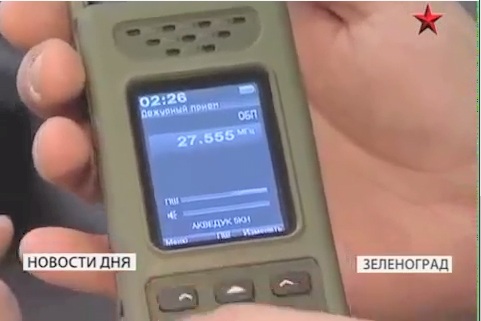Despite the rumors, the Russian are not using Baofeng Two Way radios in Ukraine invasion.
They are using more modern and advanced communication systems, many of them head to head to NATO ones and even better than the Motorola DP4801 used by Ukraine forces.
They are also use MotoTrbo radios like SL-1600 but these are supposed to be captured and used for eavedropping to enemy comms.
The most interesting of all is the AZART system.
AZART R178 is a sixth generation SDR radio able to do almost every waveform.The tactical radios communicate on frequencies between 27-520MHz at ranges up to 4 kilometres. The MoD states they can also communicate with mobile phones and can receive modulated signals – the turning of digital data into radio signals.
The AZART-P1 (designated R-187) appears to have entered service in 2017, with deliveries continuing intermittently thereafter. It is designed to provide secure, jam-resistant communications for the Russian armed forces.

The R-187-P1E portable radio station has an inbuilt IR port and USB interface to plug in the PC.
The radio station has:
►an automatic relay mode and
►a time division multiplex mode.
Inbuilt means of packet switching ensure interconnectivity of the Azart system with data transfer networks and civil cellular radio telephone networks. This advantage can be used by Special Forces units when conducting missions in urban areas.
Algorithms integrated into the radio stations' software allow realization of network solutions with properties of self-organization and self-recovery.
It enables establishment of distributed digital networks in the combat area using only two types of radio stations in portable and vehicle-mounted versions.
Integrated navigation means provide self-positioning with accuracy of 25 m in latitude/longitude and 40 m in altitude. It is possible to exchange data on positions of subscribers in automatic and manual modes.
The R-187-P1E portable radio station has an inbuilt IR port and USB interface to plug in the PC.
The radio station has:
►an automatic relay mode and
►a time division multiplex mode.
Inbuilt means of packet switching ensure interconnectivity of the Azart system with data transfer networks and civil cellular radio telephone networks. This advantage can be used by Special Forces units when conducting missions in urban areas.
Algorithms integrated into the radio stations' software allow realization of network solutions with properties of self-organization and self-recovery.

Portable radio station "Azart-P1" provides the following types and modes of operation:
- voice transmission both in analog form (FM) and in digital form (TETRA, PRCH) in simplex negotiation mode;
- data transfer at speeds up to 7.2 kbps;
- pseudo-random frequency tuning at a rate of 20,000 jumps per second;
- determination of coordinates using space radio navigation systems (CRNS) GLONASS / GPS with a positioning accuracy of at least 25 m in latitude and longitude and 40 m in height (using only C / A - code);
- scanning reception at predetermined frequencies (FM);
- duty reception;
- time division relaying (TETRA);
- text messaging (TETRA);
- signal-code communication;
- automated input of radio data via wired and wireless channels.
- operating temperature range from minus 30 to plus 55 degrees C;
- range of extreme temperatures from minus 50 C to plus 55 degrees C;
- there are no requirements for stability when exposed to a shock wave, ionizing radiation, electromagnetic and light pulses of a nuclear explosion, acoustic noise, mold fungi, salt (sea) fog, special media (rocket fuel components).
The time of continuous operation of the product from one rechargeable battery should be: at least 6 hours for BA PAKD.563511.001 and at least 12 hours for BA-12 PAKD.563511.005 with a transmission / reception / duty reception time ratio of 1:1:9.
The operating frequency range of the product in the VHF range should be 27 ... 220 MHz, in the UHF1 range 220 ... 520 MHz with an operating frequency grid step: - 1; 6.25; 8.33; 12.5; 25 kHz in the VHF band; - 25; 250; 500; 1000 kHz in the UHF1 range
- automated input via wireless Bluetooth and infrared channel;
- automated input via a wired channel;
- manual input from the front panels;
- automated performance monitoring;
- input via communication channel;
- emergency erasure.
The transceiver PAKD.464113.006 of the product must have interfaces for setting (configuring) RS-485, USB2.0.
The communication range of the product when operating in the PF mode with the same type of radio stations and at the maximum output power of the transceiver must be at least 4 km and provided during 99% of the time of the day, at any time of the year and on 90% of the terrain, at frequencies free from interference, in the parking lot and in motion on medium terrain.
The product must provide the following type of services
- voice transmission in duplex negotiation mode between 2 subscribers (if TETRA infrastructure is available);
- file exchange in TETRA mode;
- voice transmission in the simplex mode of negotiating between several subscribers simultaneously (circular communication);
- voice transmission in the simplex mode of negotiation between 2 subscribers;
- exchange of navigation information in TETRA mode;
- transmission of text messages in real time in TETRA mode;
- signal-code communication in TETRA mode;
The product must provide software-defined tuning according to the pseudo-random law of frequency channels (frequency hops), with a maximum speed of at least 20,000 hops per second.
The product must provide counter-operation on the same sections of the frequency range with radio stations R-163, R-168, R-169 and "Duet" in the FChS mode.
The device for inputting radio data via the USB interface must provide reading and writing information, the maximum amount of stored information is 512MB.
Dimensions of the transceiver PAKD.464113.006 no more than (195×70×40) mm.















No comments:
Post a Comment